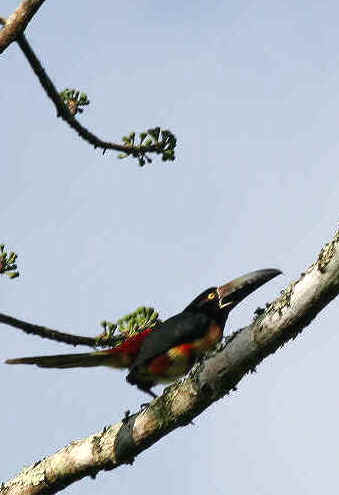
E-mail: font@focusonnature.com
Phone: Toll-free in USA 1-888-721-3555
or 302/529-1876
 |
PO Box 9021,
Wilmington, DE 19809, USA E-mail: font@focusonnature.com Phone: Toll-free in USA 1-888-721-3555 or 302/529-1876 |
THE FOCUS ON NATURE TOUR IN CENTRAL & EASTERN PANAMA
July 2013
"Anis, Aracaris, Anhinga, & also an Agami"

Collared Aracari
Links:
List of Birds during our Panama Tours - February '06
Upcoming FONT Birding & Nature Tours in Panama
The following account written by Armas Hill, leader
of the tour:
Panama is an isthmus, that is a "land bridge" between two major
continents. Birds, mammals, butterflies, and plants of those two continents,
South and North America, mesh together in the relatively small, and certainly
narrow country of Panama.
During our tour, February 3-9,
2006, we traveled from
the link between the two oceans, the Panama Canal, east into
Darien Province.
As
we went east along the Pan American Highway, toward and in Darien, we were going
closer to South America. The birds we saw reflected that.
(By the way, one can not drive on the Pan American Highway, or any road, from
Central America into South America. There's quite a gap in the highway in the
region where Panama and Colombia meet. As one drives eastward in Panama, the Pan
American highway dead-ends.)
Among the South American birds that reach their usual northern limit in Panama
are the Wattled Jacana, Southern Lapwing, Black-chested Jay, and Greater Ani.
These species, and some others, are routinely seen as far north, or west (depending how one views Panama) to the Canal Basin.
Some other South American
species are more likely to be seen in eastern Panama and the province of Darien.
Those in that category that we saw included: Cocoi and Capped Herons, Red-and-green Macaw, Golden-green
Woodpecker, One-colored Becard, Pied Water-Tyrant, and Orange-crowned
Oriole.
Some of the birds that we saw in eastern Panama are restricted, with a limited
range, only to eastern Panama and adjacent Colombia.
Such birds are:
Double-banded Graytail, Black Antshrike, White-headed Wren, Black Oropendola,
and White-eared Conebill. The last of these was one of our favorites. The
species was in a small flock, active in the trees, rather reminiscent of
chickadees, or bushtits.
Their plumage was also somewhat similar to chickadees, with their black-caps.
Nearby on a treetop branch, a black-and-white Pied Puffbird sat, as still
as could be.
One of the unique features of the Darien landscape, along the Pan American
Highway, are the large Cuipo Trees. Easily distinguished, and with huge trunks,
they are spread out across the countryside.
Not only is there that big tree in
Darien, there are some big birds too. We saw, for example, Wood Stork,
Red-and-Green Macaw, and King Vulture.
And we also saw an assortment of other raptors,
including: Gray-headed Kite, Hook-billed Kite, Pearl Kite, Great Black Hawk,
Gray (-lined) Hawk, Roadside Hawk, Short-tailed Hawk, Crane Hawk, Yellow-headed
Caracara, American Kestrel, as well as one particular raptor that
is quite rare in Panama, the Bay-winged Hawk (known as the Harris' Hawk
in North America).
We saw one, and we had a good look at it, perched in a tree quite close in fact to the road. In
the book "A Guide to the Birds of Panama" by Robert Ridgely, it's
noted that the species in Panama is "apparently rare", and that there
have been 3 "old specimens", one of which, incidentally, was taken
years ago near where our bird was seen in February 2006.
One could surely say that the best raptor (and certainly one of the best birds)
of our Feb '06 Panama Tour was the Red-throated Caracara. That species probably
has the unfortunate distinction of the being the Central American bird that has
declined the most in recent years. It's been in all the Central American bird
books, including those for Mexico, Guatemala, Costa Rica, and Panama. But
sightings in countries north of Panama lately have either very rare (in maybe
Costa Rica), or non-existent (north or west of there).
In "A Guide to the Birds of Mexico and Northern Central America"
by
Steve Howell & Sophie Webb, published in 1995, it's written that there have
been "no reports (of the Red-throated Caracara) in over 20 years west of
the Sula Valley (in Honduras)". That goes back to the early 1970s.
In the "Birds of Guatemala", Hugh Land, published in 1970, it was
written that the bird was rare in the Pacific lowland of that country. Since
that time, suitable habitat there for the species (forest) has completely
disappeared. Also, in that book, it noted that the subspecies from Mexico to
Panama was Daptrius americanus guatemalensis.
More recent taxonomy (in
"The
Howard & Moore Complete Checklist of the Birds of the World") is
different.
The only species still in the genus Daptrius is the Black Caracara
of
the Amazonian region of South America. The Red-throated Caracara is now the only
member of its own genus. It is Ibycter americanus, and, according to the recent
literature, there are no subspecies. If that subspecies guatemalensis were still
valid, it would be close to extinction.
In "A Guide to the Birds of Costa Rica" by F. Gary Stiles &
Alexander Skutch, published in 1989, it was written that the Red-throated
Caracara "is only in that country where forest remains intact in the Golfo
Dulce lowlands (of southwestern Costa Rica)". It had been, according to
that book, at one time, "widespread and fairly common in moist and wet
forests of both slopes from sea level locally up to 4,000
feet".
In "A Guide to the Birds of Panama" by Robert Ridgley, published in
1989, it's said that the Red-throated Caracara only "seems to remain in
Panama in any numbers in part of the eastern Panama province and in
Darien". It's also stated that the bird "disappeared from the Canal
Zone area during the 1950s and 1960s" and that it "was formerly known
to occur in the Chiriqui province of western Panama".
In South America, the Red-throated Caracara occurs where forest continues in the
Amazonian region.
Where there are Red-throated Caracaras (they're normally in groups), they're
often heard before they're seen. They are loud and raucous. At a distance its
call can be similar to that of a macaw.
The most common call of the bird is a
trumpeting and hoarse "khaaow", that is sometimes varied to
"ca-ca'-o". That's what Stiles & Skutch wrote.
Land wrote
"the loud and harsh call sounds like the Spanish word 'cacao' with the
first syllable repeated several
times".
During our Feb '06 tour in Darien, as we were in a boat traveling down a remote
river, it was first the loud call of the Red-throated Caracara that caught our
attention (as noted, at first sounding rather like a macaw). We continued
further along the river, and then we both heard and saw the birds (there were a
few) in trees on the west bank. At first, not everyone had the clear view they
wanted of the species in the foliage. But evidently, the birds themselves wanted
to be better seen, as they stayed still in the trees, even as our guide and
boatman cleared away some lower branches that impeded the view. After a few
moments of that "clearing away" activity, a wonderful view was
miraculously had by all of that most-desired
bird.
The Crane Hawks during that boat-ride, on the other hand, were seen very
easily, as they were down low on the dirt banks of the river, probing for food.
That unique hawk (the single member of its genus), with its long body and red
legs, was of course a treat to see as closely as we saw
it.
Among other birds seen during that river boat-ride in
Darien, there was an Agami
Heron (that one is always a treat to see!), both Green-and-rufous and
American Pygmy Kingfishers, Blue Ground Doves, a group of Purple-thraoted
Fruitcrows, Cinnamon Woodpecker, White-headed Wren, and both Yellow-backed
and Yellow-tailed Orioles.
In the lower foliage, Greater Anis were by the river.
In the upper
branches of the trees, there were Collared Aracaris.
On branches out over
the river, and in the river itself, there were Anhingas.
All 3 of the
birds just mentioned, are with names (as you may have noticed) beginning
with the letter "a", (ani, aracari, and anhinga).
All of those names are from the language of the Tupi
tribe of indigenous people in Brazil. Our boatmen, along the remote
river in Darien, were indigenous people, not Tupi of course but the Embara
tribe.
It was all really quite an experience in a wild area - and the
"good birds" of course enhanced it.
That Agami Heron, during our ride, that was stalking along the riverbank,
could not in any way ever be mistaken for an Anhinga, but it is true that the
long neck and the slender and angled head of the bird does bear a resemblance.
One can also wonder if the derivation of the name "Agami" for
that bird along the forest river is, like the Anhinga (and the Aracari
& Ani), from the Tupi tribe of Brazil, in the area of
the biggest of American rivers, the
Amazon.
Yes, the Darien province of Panama is wild, just about everywhere.
As one
travels about, a good barometer of that are the constant calls of Tinamous
(both Little and Great). Generally, throughout
Central America, it's been that as the "wildness" of an area
diminishes, the melodic calls of tinamous decrease.
After nightfall, in the Darien countryside, there were many calls of Pauraques.
And, as we went along a dirt road after dark, there were both Barn and Striped
Owls. The stars and planets shined brightly in the ever-so-clear sky
overhead. Even though we had driven from Panama City, the noisy and bright
accompaniment of the city seemed (and really was) so very far away!
Back when we were in Panama City, earlier during the tour, we saw two rarities
for Panama: a Long-billed Curlew and a Ring-billed Gull.
Also earlier in the tour, when we in the Canal Basin, among the many birds
there, maybe our best sight was that of the strikingly attractive male Golden-collared
Manakin, as it was perched close to us. There are good birds to see and
enjoy just about anywhere in Panama!
But back again in Darien, this summary will conclude in a small town, where
twice we spent the night.
By the road into town, in a field, there was Crested
Bobwhite, and in a marsh, there were Purple Gallinules. Further down
the road, in large trees, there were Black-chested Jays.
In the town,
itself, in trees near the streets and houses, there always seemed to be birds.
A
number of them were common, yes, but it was nice to have that number of them.
As
we had breakfast, on a table outside by the sidewalk, among birds in view there
were: Black-throated Mango, Streaked Flycatcher, other more-common
flycatchers, Tropical Mockingbird and Tropical Gnatcatcher, Bananaquits,
Yellow-crowned Euphonia, and Tanagers including Blue-gray, Palm,
Plain-colored, Crimson-backed, and Lemon-rumped.
And don't let that
name "Plain-colored" fool you. They're nice to have, too, as
all the other birds were.
Also, as we were having breakfast by the sidewalk in
that town that morning, with the birds about, people of the indigenous Kuna
tribe somehow came along (they learned we were there), in
their colorful attire, selling some also-colorful small sculptures of the more
dramatic, big birds that occur in eastern Panama, away of course from the small
town. Their ceramic sculptures were of birds such as the Harpy Eagle, the
toucans, and parrots and macaws.
When we were there, we didn't have to pinch ourselves to realize that we were
somewhere so "far away" and very different from what it would have
been in our "normal lives", as we
were in the remote countryside of wild Panama, in
Darien.